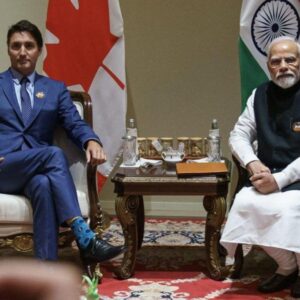Just when the G20 summit in India was wrapping up with smiles all around, Canadian Prime Minister Justin Trudeau found himself stuck in New Delhi thanks to his aircraft. Talk about bad timing!
And since that day, the vibes between India and Canada have taken a nosedive.
So, where did it all begin?
It started with the tragic killing of Hardeep Singh Nijjar in Canada. But who exactly was Hardeep Singh Nijjar?
Well, he became a big name in the pro-Khalistan movement in Canada after moving there in 1996. He played a key role in groups like Sikhs for Justice and even founded the Khalistan Tiger Force (KTF).
Decades later, India labelled the KTF a terrorist organisation, saying it received financial and logistical support from foreign sources to carry out terrorist activities in India. This was the reason why Indian authorities were behind Nijjar for years officially declaring him a terrorist in 2020.
In 2018, his name was added to a list of wanted criminals handed to Canadian Prime Minister Justin Trudeau. And in June, Nijjar was shot dead in Canada by gunmen who were not related to India at all.
But now, Justin Trudeau accused India of involvement in the killing of Hardeep Singh Nijjar in Canada. Following his statement, an Indian diplomat named Pavan Kumar Rai was expelled.
In response, India lost its cool, and ordered a senior Canadian diplomat, Olivier Sylvestere, to leave the country, in a tit-for-tat move.
However, the financial connections between India and Canada are pretty strong from both sides.
1. Investments between the two countries have risen significantly to Rs. 2.24 lakh crore in 2022, a 37% increase in just four years.
2. Over 600 Canadian companies operate in India, and more than 1,000 Canadian companies are actively doing business in the Indian market.
3. There are over 3.19 lakh Indian students in Canadian institutions, contributing $4.9 billion to the Canadian economy, making India the largest source of foreign students, according to the latest data from various sources.
4. India’s total exports to Canada were worth $4,109.74 million in FY23, which was about 0.9% of India’s total exports ($450,958.43 million) last FY.
Whereas India’s total imports from Canada in FY23 reached $4,051.29 million, making up nearly 0.6% of India’s total imports of $714,042.45 million in FY22.
5. Canada exported goods and services worth Rs. 71,700 crores including commodities like lentils, timber, metallurgical coal and newsprint to India, and India’s primary exports have been smartphones, railway cars, pharmaceuticals, gems and jewellery, textiles, and machinery.
Now, the big question is – Will there be any impact on the growing economic relationship between the two countries?
Well, there’s been some impact already on the economic side. Canada called for a pause on talks about the free trade agreement, which was supposed to happen this year, because of political concerns. These tensions could potentially disrupt plans to boost trade and investment between the two nations.
But here’s the twist: Experts don’t think these fresh tensions will hurt trade and investments much. That’s because the economic relationship is mainly driven by commercial interests, not politics.
India and Canada do not deal in similar products, which means their trade relationships may not be affected by these recent events.
In the past, some tensions or challenges in India-Canada relations have included:
- Khalistan Issue: The Khalistan movement, which seeks an independent Sikh state, has been a contentious issue in India-Canada relations. Some Canadian politicians have been associated with Sikh separatist groups in the past, leading to diplomatic tensions. India has expressed concerns about these activities on Canadian soil.
- Trade and Market Access: Trade issues can also affect bilateral relations. Disputes related to trade policies, market access, or regulatory matters can arise and impact the economic relationship between the two countries.
- Human Rights: Canada has, at times, raised concerns about human rights issues in India, particularly related to religious and ethnic minorities. These concerns have occasionally strained diplomatic ties.
- Citizenship and Immigration Policies: Changes in immigration and citizenship policies in Canada and the treatment of certain groups, such as Indian international students, can also influence bilateral relations.
- Global Issues: India and Canada have different positions on various global issues, including climate change, United Nations reforms, and international peacekeeping. These differences can affect cooperation on the international stage.
- Diplomatic Incidents: Like any two countries, India and Canada may encounter occasional diplomatic incidents that can strain relations. These incidents can range from visa disputes to disagreements over diplomatic protocols.
It’s essential to consult current news sources and official government statements for the most up-to-date information on India-Canada relations. Diplomatic relations between countries can fluctuate due to a variety of factors, and maintaining open channels of communication and diplomacy is crucial to addressing and resolving any issues that may arise.
What went wrong between India and Canada? Check the details!
[contact-form][contact-field label=”Name” type=”name” required=”true” /][contact-field label=”Email” type=”email” required=”true” /][contact-field label=”Website” type=”url” /][contact-field label=”Message” type=”textarea” /][/contact-form]



